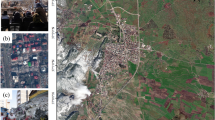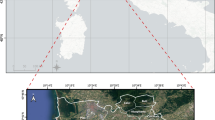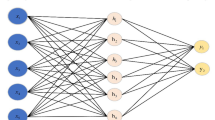Abstract
Liquefaction is one kind of earthquake-induced disasters which may cause severe damages to roads, highways and buildings and consequently delay the disaster rescue and relief actions. A fast and reliable assessment of liquefaction disaster is thus of great importance for making disaster prevention plans beforehand and for planing rescue and relief activities right after earthquakes. However, this is still a great challenge task, because the computational cost of current existing liquefaction assessment methods is very high. For example, a 50 seconds simulation (5000 time steps) needs one hour with 1000 nodes in the Supercomputer K. In this paper, we proposed a machine learning based liquefaction disaster assessment method. Here, the assessment result can be given with high efficiency (few seconds or less) for emergency evacuation in an earthquake. Meanwhile, a multi-layer approach was also proposed. Firstly, the most dangerous area will be shown immediately by using convolutional neural network (CNN) model; followed by a high precision result, which is obtained by using fast Fourier transform and a special of soil (N values) coupled with a Light Gradient Boosting Machine (Light GBM) model. One more contribution is our visualization design, which can be used to let users know the dangerous area more intuitively. Finally, the effectiveness of our proposed method was demonstrated by assessing liquefaction from a large-scale earthquake simulation.







Similar content being viewed by others
References
Bi, C., Yuan, Y., Zhang, J., Shi, Y., Xiang, Y., Wang, Y., Zhang, R.: Dynamic mode decomposition based video shot detection. IEEE Access 6, 21397 (2018)
Bi, C., Yuan, Y., Zhang, R., Xiang, Y., Wang, Y., Zhang, J.: A dynamic mode decomposition based edge detection method for art images. IEEE Photon. J. 9 (6), 1 (2017)
Biot, M.: Theory of propagation of elastic wave in a fluid-saturated porous solid. J Acoust Soc Am 28(2), 168 (1956)
Chen, J., Takeyama, T., O-Tani, H., Fujita, K., Hori, M.: A framework for assessing liquefaction hazard for urban areas based on soil dynamics. Int. J. Comput. Method. 13(04), 1641011 (2016)
Chen, J., Takeyama, T., O-Tani, H., Fujita, K., Motoyama, H., Hori, M.: Using high performance computing for liquefaction hazard assessment with statistical soil models. Int. J. Comput. Method 15(2), 1840005 (2018)
Chen, Q., Song, X., Yamada, H., Shibasaki, R.: Learning Deep Representation from Big and Heterogeneous Data for Traffic Accident Inference. In: AAAI Conference on Artificial Intelligence, pp. 338–344 (2016)
Chen, T., Guestrin, C.: Liquefaction investigation of Wenchuan earthquake. In: ACM SIGKDD International Conference on Knowledge Discovery and Data Mining, pp. 785–794 (2016)
Cubrinovski, M., Henderson, D., Bradley, B.: Liquefaction impacts in residential areas in the 2010-2011 Christchurch earthquakes. In: Proceedings of the International Symposium on Engineering Lessons Learned from the 2011 Great East Japan Earthquake, pp. 811–824 (2012)
Cubrinovski, M., Ishihara, K., Pipatpongsa, T., Tanizawa, F.: Numerical simulation of the Kobe Port-Island liquefaction. In: Proceedings of the 11th World Conference on Earthquake Engineering, p 330 (1996)
Dhanya, J., Raghukanth, S.T.G.: Ground motion prediction model using artificial neural network. Pure Appl. Geophysics 175(3), 1035 (2018)
Erzin, Y., Ecemis, N.: The use of neural networks for cpt-based liquefaction screening. Bull. Eng. Geol. Environ. 74(1), 103 (2015)
Fang, J.T., Chang, Y.R., Chang, P.C.: Deep learning of chroma representation for cover song identification in compression domain. Multidim. Syst. Sign. Process. 29, 887 (2018)
Farid, D.M., Zhang, L., Rahman, C.M., Hossain, M.A., Strachan, R.: Hybrid decision tree and naïve bayes classifiers for multi-class classification tasks. Expert Syst. Appl. 41, 1937 (2014)
Fujita, K., Ichimura, T., Hori, M., Wijerathne, M., Tanaka, S.: A quick earthquake disaster estimation system with fast urban earthquake simulation and interactive visualization. Procedia Comput. Sci. 29, 866 (2014)
Gordan, B., Armaghani, D.J., Hajihassani, M., Monjezi, M.: Prediction of seismic slope stability through combination of particle swarm optimization and neural network. Eng. Comput. 32(1), 85 (2016)
Gu, Y., Gu, M., Long, Y., Xu, G., Yang, Z., Zhou, J., Qu, W.: An enhanced short text categorization model with deep abundant representation. World Wide Web, 1–15 (2018)
Güllü, H., Ercelebi, E.: A neural network approach for attenuation relationships: an application using strong ground motion data from turkey. Eng. Geol. 93(3-4), 65 (2007)
Hasni, H., Alavi, A.H., Jiao, P., Lajnef, N.: Detection of fatigue cracking in steel bridge girders: a support vector machine approach. Archives Civil Mech. Eng. 17(3), 609 (2017)
Huang, Y., Zhang, F., Yashima, A., Ye, W.: Numerical simulation of mitigation for liquefaction-induced soil deformations in a sandy ground improved by cement grouting. Environ. Geol. 55, 1247 (2008)
Ishihara, K.: Soil Behaviors in Earthquake Geotechnics. Oxford Science Publication, Oxford (1996)
Jha, S., Suzuki, K.: Reliability analysis of soil liquefaction based on standard penetration test. Comput. Geotech. 36(4), 589 (2009)
Kaya, Z.: Predicting liquefaction-induced lateral spreading by using neural network and neuro-fuzzy techniques. Int. J. Geomechanics 16(4), 04015095 (2016)
Kazama, M., Noda, T.: Damage statistics (summary of the 2011 off the pacific coast of tohoku earthquake damage). Soils Found. 52(5), 780 (2012)
Ke, G., Meng, Q., Finley, T., Wang, T., Chen, W., Ma, W., Liu, Q.Y.T.Y.: Lightgbm: a highly efficient gradient boosting decision tree. Advan. Neural Inform. Process. Syst., 1–9 (2017)
Kohestani, V.R., Hassanlourad, M., Ardakani, A.: Evaluation of liquefaction potential based on cpt data using random forest. Nat. Hazards 79(2), 1079 (2015)
Krawczyk, B., Woniak, M., Schaefer, G.: Cost-sensitive decision tree ensembles for effective imbalanced classification. Appl. Soft Comput. 14, 554 (2014)
Li, H., Wang, Y., Wang, H., Zhou, B.: Multi-window based ensemble learning for classification of imbalanced streaming data. World Wide Web 20, 1507 (2017)
Manek, A.S., Shenoy, P.D., Mohan, M.C., Venugopal, K.R.: Aspect term extraction for sentiment analysis in large movie reviews using gini index feature selection method and svm classifier. World Wide Web 20, 135 (2017)
Muduli, P.K., Das, S.K.: Model uncertainty of spt-based method for evaluation of seismic soil liquefaction potential using multi-gene genetic programming. Soils Found. 55(2), 258 (2015)
Oka, F., Kimoto, S.: Computational Modelling of Multiphase Geomaterials. CRC Press, Boca Raton (2012)
Poulos, S., Castro, G., France, J.: Liquefaction evaluation procedure. J Geotech. Engrg. 111(6), 772 (1985)
Samui, P., Kim, D., Hariharan, R.: Determination of seismic liquefaction potential of soil based on strain energy concept. Environ. Earth Sci. 74(7), 5581 (2015)
Society, T.J.G.: Soil liquefaction survey in kanto district during the 2011 off the pacific coast of tohoku earthquake. Tech. rep., Ministry of Land, Infrastructure, Transport and Tourism, Kanto Regional Development Bureau. In Japanese (2011)
Song, X., Shibasaki, R., Yuan, N.J., Xie, X., Li, T., Adachi, R.: Deepmob: learning deep knowledge of human emergency behavior and mobility from big and heterogeneous data. ACM Transactions on Information Systems (TOIS) 35(4), 41:1 (2017)
Song, X., Zhang, Q., Sekimoto, Y., Horanont, T., Ueyama, S., Shibasaki, R.: Intelligent system for human behavior analysis and reasoning following large-scale disasters. IEEE Intell. Syst. 28(4), 35 (2013)
Song, X., Zhang, Q., Sekimoto, Y., Shibasaki, R., Yuan, N.J., Xie, X.: A Simulator of Human Emergency Mobility following Disasters: Knowledge Transfer from Big Disaster Data. In: AAAI Conference on Artificial Intelligence, pp. 730–736 (2015)
Song, X., Zhang, Q., Sekimoto, Y., Shibasaki, R., Yuan, N.J., Xie, X.: Prediction and simulation of human mobility following natural disasters. ACM Transactions on Intelligent Systems and Technology (TIST) 8(2), 29:1 (2017)
Sudo, A., Kashiyama, T., Yabe, T., Kanasugi, H., Song, X., Higuchi, T., Nakano, S., Saito, M., Sekimoto, Y.: Particle Filter for Real-time Human Mobility Prediction following Unprecedented Disaster. In: International Conference on Advances in Geographic Information Systems, pp. 5:1–10 (2016)
Wang, X.W., Nie, D., Lu, B.L.: Emotional state classification from eeg data using machine learning approach. Neurocomputing 129, 94 (2014)
Wen, Z., Zhang, R., Ramamohanarao, K., Yang, L.: Scalable and fast svm regression using modern hardware. World Wide Web 21, 261 (2018)
Xue, X., Liu, E.: Seismic liquefaction potential assessed by neural networks. Environ. Earth Sci. 76, 1 (2017)
Yang, L., Wang, B., Zhang, R., Zhou, H., Wang, R.: Analysis on location accuracy for the binocular stereo vision system. IEEE Photon. J. 10(1), 7800316:1 (2018)
Zhang, J., Lafta, R.L., Tao, X., Li, Y., Chen, F., Luo, Y., Zhu, X.: Coupling a fast fourier transformation with a machine learning ensemble model to support recommendations for heart disease patients in a telehealth environment. IEEE Access 5, 10674 (2017)
Zhang, X., Hu, B., Chen, J., Moore, P.: Ontology-based context modeling for emotion recognition in an intelligent Web. World Wide Web 16, 497 (2013)
Zhao, X., Bi, X., Qiao, B.: Probability based voting extreme learning machine for multiclass xml documents classification. World Wide Web 17, 1217 (2014)
Zheng, W., Tang, H., Qian, Y.: Collaborative work with linear classifier and extreme learning machine for fast text categorization. World Wide Web 18, 235 (2015)
Acknowledgements
We would like to thank Professor Takeyama Tomohide for his suggestion in liquefaction disaster assessment, and anonymous reviewers for their valuable comments.
Author information
Authors and Affiliations
Corresponding authors
Additional information
Publisher’s Note
Springer Nature remains neutral with regard to jurisdictional claims in published maps and institutional affiliations.
This article belongs to the Topical Collection: Special Issue on Big Data for Effective Disaster Management
Guest Editors: Xuan Song, Song Guo, and Haizhong Wang
This work was partly supported by the National Natural Science Foundation of China under Grant No. 61702360, partly by the Tianjin Natural Science Foundation of China under Granted No. 16JCQNJC04100, partly supported by the FOCUS Establishing Supercomputing Center of Excellence and by the Council for Science, Technology and Innovation(CSTI), Cross-ministerial Strategic Innovation Promotion Program (SIP), “Enhancement of societal resiliency against natural disasters” (Funding agency: JST). This research used the computational resources of the K computer provided by RIKEN Center for Computational Science.
Rights and permissions
About this article
Cite this article
Bi, C., Fu, B., Chen, J. et al. Machine learning based fast multi-layer liquefaction disaster assessment. World Wide Web 22, 1935–1950 (2019). https://doi.org/10.1007/s11280-018-0632-8
Received:
Revised:
Accepted:
Published:
Issue Date:
DOI: https://doi.org/10.1007/s11280-018-0632-8




